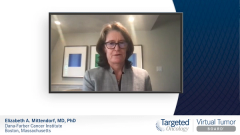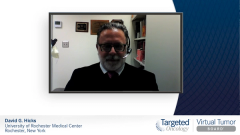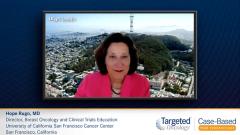
Case 2: Considerations for PARP Inhibitor Use in TNBC
Experts in the management of breast cancer review some treatment considerations surrounding the use of PARP inhibitors in BRCA1/2–positive triple-negative breast cancer.
Episodes in this series

Elizabeth A. Mittendorf, MD, PhD: Continuing with this patient, when you counsel her about her BRCA mutation and the use of PARP inhibitors, what efficacy do you typically tell these patients that they can expect to see from these agents?
Ruta Rao, MD: Usually, it depends on the patient, what their level of health literacy is, and what questions they want to ask. Some patients—you probably get more of these at Dana-Farber Cancer Institute in Boston than we do on the west side of Chicago at Rush University Medical Center—really want to know the details. They might have even read the studies before they come in. The 1 thing that’s important to emphasize is how patients sometimes misinterpret some of the data. They look at the median PFS [progression-free survival] and say, “I’m going to be on this drug for whatever the median PFS was.” You have to explain to them, “No, we can’t predict how long you will be on this drug.” In general, I go through what the PFS improvements are, what the expected response rate is for any therapy that I would prescribe for a patient, and a balanced discussion of the adverse effects.
Elizabeth A. Mittendorf, MD, PhD: As we have done in all our conversations this evening, let’s weave PD-L1–positive breast cancer into this discussion. I apologize, did you say she was PD-L1 positive and is somebody who is stage IV de novo—so no prior chemotherapy? Would that change the recommendation for PARP or starting with PD-L1? What do you think about that?
Ruta Rao, MD: I would still start with a PARP in a patient like this. I want to avoid some of the toxicity that we see from chemotherapy. But it would be nice to know that we have that option as another treatment option for this patient. That being said, I don’t think there’s a wrong answer. If someone else chose to start with chemotherapy plus immunotherapy, and if this patient happened to be PD-L1 positive, that would be completely appropriate as well.
Elizabeth A. Mittendorf, MD, PhD: All right. If PD-L1 inhibition is good and PARP inhibition is good, what about giving them both? What data do we have looking at the combination of immunotherapy and PARP inhibitors?
Ruta Rao, MD: We have some trials ongoing to see what the benefits are of giving immunotherapy along with a PARP inhibitor. There’s the TOPACIO trial, or KEYNOTE-162, where they looked at niraparib [Zejula] and pembrolizumab [Keytruda]. The MEDIOLA trial looked at durvalumab [Imfinzi] and olaparib [Lynparza]. The MEDIOLA trial showed that the combination was significantly active and relatively well tolerated. We just need to see more mature and phase 3 data on these combinations. That may be the first step for a patient like this: immunotherapy plus a PARP inhibitor.
Elizabeth A. Mittendorf, MD, PhD: David, go ahead.
David G. Hicks, MD: I was just going to say, Beth, that there’s a biological rationale for why they may be synergistic and that these tumors already have problems with DNA repair. The PARP inhibitor will interfere with DNA repair further and probably drive additional neoantigen formation. In a sense, it could help activate the immune system and make the tumor hot. There’s a lot of talk about how to make an immunologically cold tumor hot. It may be 1 way.
Elizabeth A. Mittendorf, MD, PhD: I think you’re exactly right. That’s the rationale for combining those agents: Generate a T-cell response and then augment it by coming in with checkpoint blockade. Ruta is right. The data are a little interesting. Thinking specifically about the MEDIOLA trial, the benefit doesn’t seem to be better than a PARP inhibitor alone, but we don’t know what the tails of these curves are going to look like. Is it possible that the addition of the immunotherapy, for the reason that David just mentioned— you’re stimulating an adaptive immune response against the tumor—will extend the tail of the curve? That’s what we don’t know. Ruta’s point is that there are a number of ongoing trials. A lot of people doing work in the laboratory to try to understand how these could work together synergistically.
Transcript edited for clarity.














































